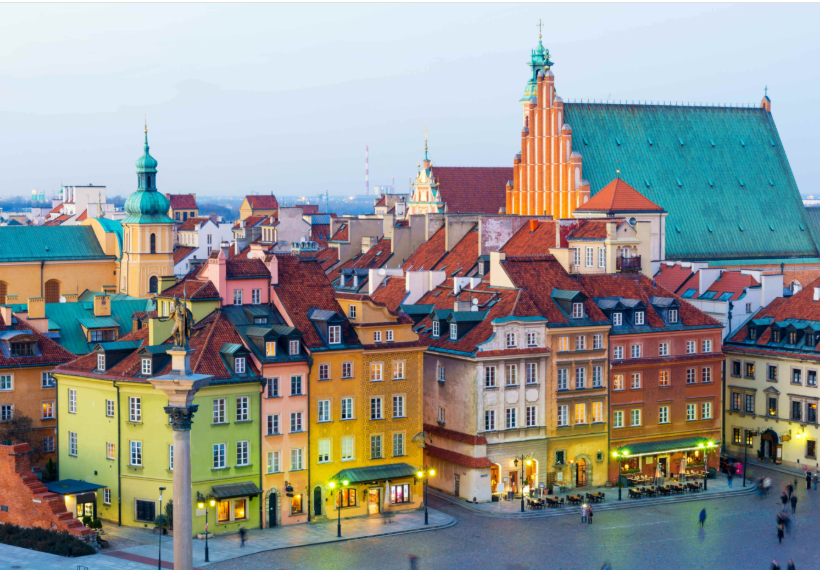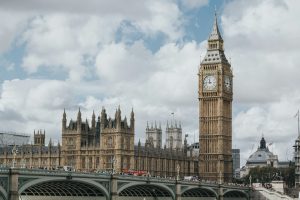Introduction
Warsaw is the capital and largest city of Poland, located in the heart of the country along the Vistula River. It is a city known for its resilience, having been nearly destroyed during World War II and meticulously rebuilt afterward. Today, Warsaw is a dynamic blend of historic architecture and modern development, featuring landmarks like the Royal Castle, Old Town, Palace of Culture and Science, and numerous museums.
- Old Town (Stare Miasto)
A UNESCO World Heritage Site, Warsaw’s Old Town is a stunning example of resilience and restoration. Destroyed during World War II, it was rebuilt from scratch using historical drawings and photographs. Today, its colorful facades, cobblestone streets, and Gothic churches capture the charm of pre-war Warsaw. Highlights include the Old Town Market Square, St. John’s Archcathedral, and the Barbican, a semi-circular fortified outpost that once protected the city.
Cultural Tip: Visit in summer to experience open-air concerts, artisan stalls, and street performances that breathe life into this historic district.
- Royal Castle (Zamek Krolewski)
At the entrance to the Old Town, the Royal Castle once served as the residence of Polish monarchs. Like much of Warsaw, it was destroyed in World War II and meticulously reconstructed. Inside, you’ll find lavish royal apartments, political chambers, and priceless art collections, including paintings by Rembrandt and Canaletto. The castle also played a pivotal role in Polish history, hosting the signing of the first European constitution in 1791.
Don’t Miss: The Great Assembly Hall—a magnificent space with gilded decor and symbolic artworks.
- Wilanów Palace (Pałac w Wilanowie)
Often referred to as the “Polish Versailles,” Wilanów Palace is a baroque masterpiece built for King Jan III Sobieski in the 17th century. The palace is surrounded by lush gardens and features a museum dedicated to Poland’s royal and artistic heritage. Unlike much of Warsaw, Wilanów survived WWII almost untouched, offering an authentic glimpse into Poland’s aristocratic past.
Cultural Highlight: Stroll through the royal gardens and attend seasonal events like the Royal Garden of Light, a spectacular evening light show.
- Palace of Culture and Science (Pałac Kultury i Nauki)
This towering socialist realist building is one of Warsaw’s most iconic and controversial landmarks. A gift from the Soviet Union in the 1950s, the Palace of Culture and Science houses theaters, cinemas, museums, and Poland’s highest viewing terrace. It also hosts cultural events, from film festivals to science exhibitions.
Insider Tip: Take the elevator to the 30th-floor observation deck for panoramic views of the city.
- POLIN Museum of the History of Polish Jews
One of Warsaw’s most acclaimed modern museums, POLIN tells the 1000-year history of Jewish life in Poland. Located on the site of the former Warsaw Ghetto, the museum combines interactive exhibits, multimedia installations, and artifacts to explore Jewish culture, traditions, and tragedies—culminating in the Holocaust and its aftermath.
Educational Note: The museum’s architecture is symbolic, with a split central hall representing the rupture caused by the Holocaust.
- Warsaw Uprising Museum
Dedicated to one of the most significant events in Warsaw’s modern history, the Warsaw Uprising Museum honors the 1944 resistance against Nazi occupation. The museum uses immersive technology, archival footage, and personal stories to convey the bravery, loss, and spirit of Warsaw’s citizens during the uprising.
Why It Matters: This is not just a museum—it’s a place of remembrance and a tribute to the resilience that defines the city.
- Fryderyk Chopin Museum
Poland’s most famous composer, Fryderyk Chopin, is celebrated in a high-tech museum located in the historic Ostrogski Palace. The Chopin Museum blends multimedia displays, interactive exhibits, and personal artifacts—including manuscripts, pianos, and letters—to tell the story of the musical genius’s life and legacy.
Music Lover’s Tip: Time your visit with the Chopin concerts in Łazienki Park, held every Sunday in summer near his monument.
- National Museum in Warsaw (Muzeum Narodowe w Warszawie)
The National Museum is one of Poland’s largest art institutions, home to an extensive collection spanning ancient art to contemporary works. Highlights include Polish 19th-century paintings, medieval religious art, and the Faras Gallery, featuring Nubian Christian frescoes from Sudan.
Special Exhibitions: The museum frequently hosts temporary exhibits featuring international artists and unique historical themes.
- Lazienki Krolewskie (Royal Baths Park)
More than just a park, Lazienki is a cultural complex featuring palaces, pavilions, and landscaped gardens. At its heart is the Palace on the Isle, an elegant neoclassical building surrounded by water. The park also includes a theater, Chinese pavilion, and a monument to Chopin, where outdoor concerts take place in summer.
Why Visit: It’s a perfect place to combine nature with culture, ideal for a peaceful afternoon stroll and a touch of royal elegance.
- Zachęta National Gallery of Art
If you’re interested in contemporary Polish art, the Zachęta Gallery is the place to go. Housed in a neoclassical building near the Saxon Garden, it showcases works by leading and emerging Polish artists across a wide range of media. The gallery plays a key role in Warsaw’s cultural dialogue and often features experimental and thought-provoking exhibits.
Creative Tip: Look out for artist talks, workshops, and events that connect modern art with broader social themes.
Where to stay in Warsaw
- Old Town (Stare Miasto) – Best for First-Time Visitors & Sightseeing
- Why stay here: Historic charm, close to top attractions like the Royal Castle and Market Square.
- Pros: Walkable, scenic, full of cafes and museums.
- Cons: Can be more expensive; fewer modern hotels.
- Recommended Hotels:
- Hotel Bellotto (luxury in a palace)
- Castle Inn (cozy and affordable right next to the castle)
- Srodmiescie (City Centre) – Best for Convenience & Culture
- Why stay here: Central location, near shopping streets, museums, restaurants, and transport.
- Pros: Well-connected; mix of modern and historic sites.
- Cons: Busy and a bit noisy.
- Recommended Hotels:
- Warsaw Marriott Hotel (luxury, great views)
- Hotel Polonia Palace (elegant and historic)
- PURO Hotel Warsaw (stylish boutique option)
- Mokotow Best for Families & Longer Stays
- Why stay here: Quieter, green parks, local vibe, good for business travelers or families.
- Pros: Safe, residential feel, close to Łazienki Park.
- Cons: Further from Old Town; more commuting.
- Recommended Hotels:
- Vienna House Mokotow Warsaw
- Platinum Residence Mokotów (apartment-style)
Things to Do in Warsaw
- Explore the Old Town (Stare Miasto)
- Stroll through the UNESCO-listed Old Town, rebuilt after WWII.
- Visit the Royal Castle, enjoy cafes at Market Square, and admire St. John’s Cathedral.
- Take photos at Castle Square with the iconic Sigismund’s Column.
- Visit the POLIN Museum of the History of Polish Jews
- One of Europe’s most impressive museums.
- Interactive exhibits explore 1000 years of Jewish life in Poland.
- Located on the site of the former Warsaw Ghetto.
- Tour the Warsaw Uprising Museum
- A moving and powerful museum dedicated to the 1944 Warsaw Uprising.
- Features immersive exhibits, photos, and personal testimonies.
- Great for understanding Warsaw’s wartime resilience.
Day Trips from Warsaw
- Zelazowa Wola – Birthplace of Chopin
- Distance: 1 hour (50 km)
- Why go: Visit the birthplace of Fryderyk Chopin, now a beautifully preserved museum set in a tranquil park.
- Highlights:
- Historic manor house
- Chopin music concerts (especially in summer)
- Scenic gardens
- Kampinos National Park
- Distance: 45 minutes
- Why go: A UNESCO biosphere reserve with hiking and biking trails, just outside the city.
- Perfect for: Nature lovers, birdwatchers, and those seeking peace.
- Activities: Forest walks, picnics, wildlife spotting
- Modlin Fortress
- Distance: 1 hour (40 km)
- Why go: One of Europe’s largest 19th-century fortresses.
- Highlights:
- Panoramic views of the Narew River
- Military tunnels and ruins
- Nearby beach and river paths




